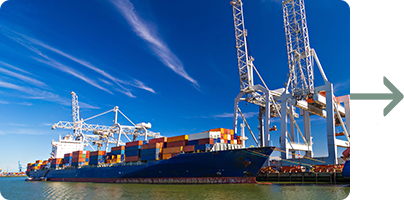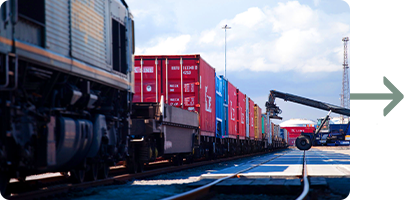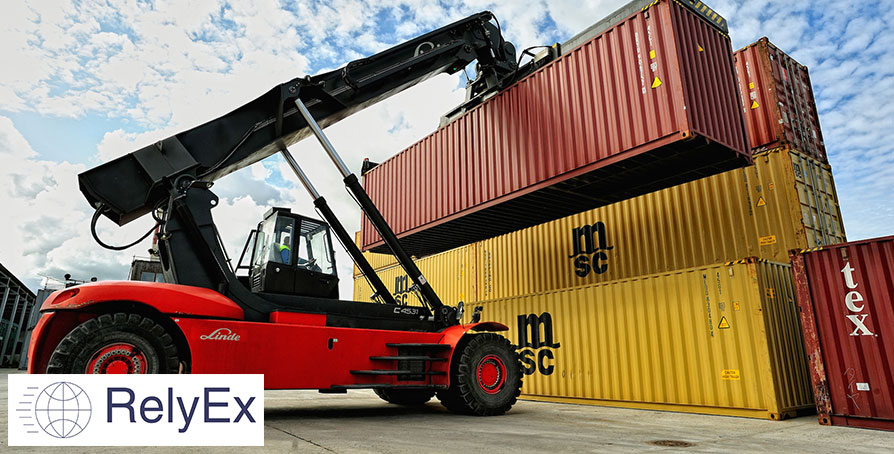Unique Logistics Solutions to Complex Container Drayage Issues
Today, more than 80% of global shipping involves containers. They're packed with everything from personal storage items in dry containers to heavy machinery on flat rack containers. For business owners shipping products, getting a container from point A to point B requires precise planning and high-level tracking. But that's easier said than done when global supply chains become over-congested, leading to loading time issues and delays.
That's bad news for business owners who are already under a massive amount of stress. The truth is that container storage delays can cripple a business, but there's a viable solution: drayage brokers in Los Angeles, CA like RelyEx. Drayage companies provide unique solutions to minimize demurrage and help ensure the successful delivery of your freight.
With more than 30 combined years of experience and a solutions-oriented team, RelyEx has quickly become the first choice for streamlined, efficient drayage services. To understand the true value of RelyEx's offerings in the global logistics industry, it helps to understand first what drayage is and why it's used.
What is Drayage and Why Is It Important?
If you're a seasoned business owner who uses port drayage to transport your products, you know exactly how important the service can be. But if you were to poll a group of random people, you may get five different definitions of the term "drayage." That begs the question, how is one of the most crucial steps in the supply chain and most vital components of global trade such a confusing concept? When you break it down, it's not too difficult to grasp.
Drayage, by definition, means the transportation of freight from an ocean port to another destination. Today, drayage is also used to describe the process of transporting products and goods over short distances or over "the first mile."
While drayage often means short-distance movements during the supply chain process, it's primarily used in the container shipping space. Drayage loads usually have arrival and departure points in the same city and don't include long-haul, national transportation.
Let us know how we can help.
drayage broker Services
Service Areas
Because a drayage load can mean a few different things, confusion among carriers is common. Many carriers link drayage with going into a port, but that isn't always true. While all drayage loads typically originate from a port of entry, there are often several legs of a drayage journey before a container turns up at its final stop. Legs of a drayage load may include:
Why Are Drayage Companies in Los Angeles, CA So Important?
You may be thinking, what's so important about drayage? It's such a small step in the container storage transport process. In reality, it's an integral piece needed in the logistics industry and a crucial part of U.S. supply chain management.
To truly understand the importance of drayage, let's use flowers as an example. Most cut flower shipments enter the market from areas in South America until they end up at Dutch auction houses. Once there, wholesalers purchase flowers in bulk and send those products to retail outlets worldwide. Because flowers are perishable, they typically need to be refrigerated and are often shipped in reefer containers. These refrigerated vessels must maintain a certain temp to prevent loss.
Drayage companies like RelyEx allow flower shippers to send their products from Argentinian ports to airports in the Netherlands with peace of mind because their products are protected. The only way to accomplish this feat is with the help of swift, meticulous port drayage services. Drayage companies allow flower shippers to send their products from Argentinian ports to airports in the Netherlands with peace of mind, because their products are protected. The only way to accomplish this feat is with the help of swift, meticulous port drayage services.
If port drayage is compromised, it can cause delays and even fines. You know the packages you get delivered to your front door from apps like Amazon? Without drayage and drayage brokers, one or two-day shipping times wouldn't even be possible.
As a multi-billion-dollar industry in the U.S. alone, it seems like drayage shipping issues shouldn't exist. But the fact is inefficiencies and congestion are still major problems at ports. Whether it's a lack of carriers, absent chassis, or overburdened terminals, delays lead to missed deadlines, lost revenue, and worse.
But anytime challenges exist, so too do innovative solutions.
QUOTE REQUEST
Port

Yard

Warehouse

Rail

The RelyEx Difference
RelyEx was created because our founders saw a need in the logistics space for more reliability and efficiency. The reality of the shipping and logistics industry is that it has become very transactional. It's an odd evolution, because most businesses seek a third-party logistics partner that is accessible, transparent, and committed to providing solutions.
As the logistics space continues to grow, it creates newfound expenses and complexities. Clients like ours know that and need a supply chain partner who is genuinely interested in their business. By understanding the needs of our customers and carriers, we can provide the most reliable, effective drayage services possible.
Unlike some drayage companies in Los Angeles, CA, we begin managing your containers before they ever hit the ports by mapping out the most efficient pathways of delivery. That way, our team can discover the best drayage pathways to expedite delivery time and reduce fees that cut into profits.
Our valued drayage customers choose RelyEx because:

RelyEx Solves Problems
At RelyEx, we like to consider ourselves problem solvers. The nature of the container drayage industry presents new challenges every day, but we're firm believers that there's a solution to every hurdle we encounter. And while some drayage businesses implement a reactive approach, RelyEx customers choose us for our proactive mindset. We take pride in solving your company's drayage challenges to help you avoid frustrating fees, missed expectations, and delayed shipments. We strive to make every transaction successful and streamlined by partnering with shippers who prioritize transparent, prompt, and accurate communication.

RelyEx Has a Unique Vantage Point
RelyEx approaches your business from the customer's perspective - a unique approach that helps us provide high-quality, effective drayage services. We've been in the customers' shoes, know their pain points, and because of that, provide first-hand solutions to stressful supply chain issues. With over 30 years of collective knowledge, our team excels in:
- Inventory Management
- Logistics
- Purchasing
- Finance
Our varied, high-level drayage shipping experience helps us achieve our overarching goal: expertly managing your freight movement needs. That way, you can direct your time and focus on growing the core aspects of your business while we handle the heavy lifting. Throw in proactive planning to avoid bottleneck situations and strong communication for transparent customer relations, and you can see why so many companies trust RelyEx.

RelyEx Nurtures Strong Carrier Relationships
When it comes to shipping logistics, it only takes one mistake by a mediocre worker to disrupt your business. That's why, at RelyEx, we pride ourselves on forming and nurturing relationships with carriers who match our standards of care. Our founding partner started his career transporting freight for companies as an on-demand carrier. He uses that knowledge to maximize the resources of our carriers so that our customer's expectations aren't just met - they're exceeded.
Why Choose RelyEx as Your
Drayage Company in Los Angeles, CA?
Based in the port city of Los Angeles, RelyEx has a keen understanding of the challenges of managing the inbound and outbound flow of containers. Our team of container drayage experts provides your business with unique solutions to nuanced shipping problems, minimizing demurrage and ensuring the successful delivery of your freight.

Customers choose RelyEx because:
- We are a reliable drayage logistics partner that manages your freight from beginning to end
- We have a rare industry vantage point with 30+ years of client-side experience
- We foster and fortify the strongest vendor relations
- We take a proactive approach to problem-solving, not a reactive approach
Let us know how we can help.
 843-885-3082
843-885-3082

Your Drayage Shipments Managed from Start to Finish
Some drayage brokers don't care how customers feel about their service as long as they sign a contract and get paid. As a solutions-oriented team, RelyEx takes the opposite approach. We're motivated by the opportunity to overachieve for our customers and to provide them with the best logistics experience possible. With professional experience as carriers and shippers ourselves, we know the roadblocks and challenges you're facing. We excel at mapping out the best plans of action to solve those problems. But that's just the start.
Our tracking experts monitor and manage every aspect of your drayage shipment from booking to delivery, 24/7. Once booked, we look for the availability of your containers hourly once they're at port. When they arrive, our team acts quickly to access your storage containers when they're available.
Plus, RelyEx ensures your company's requirements are met by the carrier during loading and delivery and provide necessary documentation as fast as possible. With real-time tracking updates and access to our customer service professionals, your team has complete visibility throughout the shipping process.
We Source Top-Notch Operators at the Best Prices
Over the years, RelyEx has built a strong network of drayage carriers, transloading locations, and container storage spaces to provide you with the best possible options to match your drayage service needs. We know that searching for quality service presents an added layer of complexity and stress to our customers. That's why we work hard to take that off your plate by connecting you with our reliable shipping partners.
With a background moving freight as an on-demand carrier, our founding partner understands how to maximize the resources and equipment of our carriers to match your needs.


We Make Transparent, Timely Communication a Priority
Like other industries, the global logistics space is complex. Mistakes will be made, and problems will happen. With those truths in mind, RelyEx has built its reputation as problem solvers. Unlike other drayage companies, we don't shy away from this industry's complexities because we take pride in solving problems. Even better, we aim to do what's needed to avoid those problems altogether.
As your logistics partner, we will provide your company with accurate, transparent, and prompt communication. If there are unexpected issues, we'll notify you immediately and will provide several options to remedy the problem. We even offer custom reporting for large clients who need at-the-moment updates and quick access to shipment documentation.
We Have Robust Project Management Experience
Why let the unpredictability of your industry dictate your success? With a background working in manufacturing, our founders are familiar with the demands of managing production schedules and sales orders. That experience makes it abundantly clear to us that every business and industry is different. If you struggle with seasonal surges or other factors, our team supports your business with a mapped-out plan and schedule, so you stay ahead of the game.
QUOTE REQUEST
How to Avoid
Demurrage Fees for Your Business
Based in the port city of Los Angeles, RelyEx has a keen understanding of the challenges of managing the inbound and outbound flow of containers. Our team of container drayage experts provides your business with unique solutions to nuanced shipping problems, minimizing demurrage and ensuring the successful delivery of your freight.
What is shipping demurrage?
Demurrage is a charge issued by a port, carrier, or railroad company for storing containers that do not load and unload their cargo promptly. Once the daily limit of free time is exceeded, shippers are charged daily demurrage fees until their cargo is shipped. Though different ports have different policies, charges can range from $75 to $150 per container, per day, for a set number of days. Additional demurrage fees are incurred if a shipper exceeds the port's parameters.

What causes demurrage charges?
Even when shippers maintain a tight schedule for unloading freight, external factors can play an uncontrollable part. Typically, shipping mistakes caused by human error trigger the most demurrage charges. Some of the most common causes of demurrage include:
- Paperwork Errors
- Payment Delays
- Documents Received Too Late

Paperwork Errors
Typically, shippers need four specific documents to clear shipments through customs: A Bill of Lading (or BOL), a commercial invoice, a packing list, and an arrival notice. Seasoned drayage brokers like RelyEx are used to preparing these documents, but new shippers tend to miss this step due to inexperience.
Payment Delays
If a shipper only pays for part of their shipment, a vessel operator may refuse to release their freight until their bill is fully paid. Payment delays lead to cargo detention at the port of entry, which triggers demurrage charges.
QUOTE REQUESTDocuments Received Too Late
Paperwork is needed when you're shipping goods with a drayage company. When documents like the Certificate of Origin or Bill of Lading arrive at their destination late, you can expect demurrage fees. RelyEx avoids this situation entirely by being proactive when submitting paperwork.
Additional causes for demurrage fees can include:
- Damaged Container Storage
- Custom Released Containers
- Storage Containers Are Too Heavy
Free Consultation
RelyEx:
The Supply Chain Partner You Can Count On
At RelyEx, we know first-hand how stressful supply chain problems can be for business owners. Though drayage shipping might seem minor on the surface, it affects every stage of your shipping process. And when inevitable hurdles manifest, RelyEx propels you over the proverbial roadblocks with a proactive mindset and a passion for challenging projects. We believe that all problems have a solution, and our unique vantage point allows us to provide first-hand solutions to customers in a wide array of industries.
When it comes to your business, don't settle for anything less than RelyEx. Contact our office today to learn more about how we make your shipping experience streamlined and stress-free.
 843-885-3082
843-885-3082
Latest News in Los Angeles, CA
Chargers OC Greg Roman's plan for Justin Herbert: Run the ball
ESPN.comhttps://www.espn.com/nfl/story/_/id/39578618/run-ball
ReactionsLike934Laugh6Wow4Interesting4Fire2Celebrate1COSTA MESA, Calif. -- Los Angeles Chargers offensive coordinator Greg Roman told reporters Thursday that he is confident the Chargers will establish a consistent running offense, which he expects to elevate quarterback ...
Reactions
Like
934
Laugh
6
Wow
4
Interesting
4
Fire
2
Celebrate
1
COSTA MESA, Calif. -- Los Angeles Chargers offensive coordinator Greg Roman told reporters Thursday that he is confident the Chargers will establish a consistent running offense, which he expects to elevate quarterback Justin Herbert.
"Can you imagine Justin Herbert with a great running game?" Roman said. "... We don't know, but I can imagine what it might look like. So that's kind of the vision."
The Chargers last had a feared rushing offense over a decade ago, ranking outside the top 10 in rushing yards per game every season since 2007. The Chargers finished 24th in rushing YPG, and running back Austin Ekeler averaged the fewest yards per carry (3.5) of his career.
"I think in this league, you can really, really help dictate the defenses if you have a strong running attack," Roman said. "If you really talk to most defensive coordinators in this league and got 'em off to the side when they're playing a really good running team, they're sweating a little bit. They're sleeping a little less that week."
Roman, who was most recently the offensive coordinator with the Ravens in 2022, put together some of the most prolific rushing offenses in sparking quarterback Lamar Jackson to win the second unanimous MVP award in NFL history in 2019. That same season, Roman won the AP Assistant of the Year award.
During Roman's four seasons with the Ravens (2019-2022), they led the league in rushing yards per game (175.2) -- a 30-yard difference between the next closest team -- in part because of Jackson's mobility. Roman led a similar rushing offense when he last coached with Harbaugh with the San Francisco 49ers from 2011 to 2014, where the 49ers were second in the NFL over that span in rushing yards per game (139.3).
Herbert isn't an immobile quarterback; that was evident last season in his 73 rushing yards against the Packers, the second most of his career, or when he scrambled and juked Raiders outside linebacker Maxx Crosby. Herbert, however, isn't the runner that Colin Kaepernick or Jackson is.
Herbert is at his best when passing, which Roman acknowledged, saying that his offense wouldn't look the way it has with Jackson and Kaepernick.
"It's going to be a little different," Roman said. "I think you're going to see probably a multiple running game. You'll probably see the use of motions and shifting, and then you'll see a pretty diverse passing game.
"... Right now, everybody's got a blank slate of who we can be or what we can do. Could be anything right now, our principles and whatnot of what we do offensively won't change, but how they come to life on the field will."
Still, Roman isn't dismissing the idea of any designed runs for Herbert next season.
"We'll give it to anybody that can gain yards," Roman said. "And then will Justin run the ball? ... It'll probably be more as a scrambler. Will we have some of that other stuff in our back pocket? Remains to be seen."
MLB players miffed at sport’s new see-through pants, relaying concerns to league
AP Newshttps://apnews.com/article/baseball-spring-training-pants-seethrough-52ccd5bcc81043f1623d2480bf5db39b
PEORIA, Ariz. (AP) — MLB’s new uniform reveal hasn’t gone very well. Now some of the rampant criticism has moved below the belt.Major League Baseball Players Association deputy executive director Bruce Meyer confirmed on Thursday that the organization is relaying concerns from players to MLB about the new pants, which are somewhat see-through. The complaints — first reported by ESPN — are ...
PEORIA, Ariz. (AP) — MLB’s new uniform reveal hasn’t gone very well. Now some of the rampant criticism has moved below the belt.
Major League Baseball Players Association deputy executive director Bruce Meyer confirmed on Thursday that the organization is relaying concerns from players to MLB about the new pants, which are somewhat see-through. The complaints — first reported by ESPN — are part of broader scorn for the new uniforms, which are designed by Nike and manufactured by Fanatics.
“I know everyone hates them,” Phillies shortstop Trea Turner said last week. “We all liked what we had. We understand business, but I think everyone wanted to keep it the same way, for the most part, with some tweaks here or there.”
MLB officials say the new uniforms improve mobility by providing 25% more stretch and also will dry 28% faster. The lettering, sleeve emblems and numbering are less bulky in an attempt to make uniforms more breathable and comfortable.
READ MORE
Keller getting biggest contract for Pirates pitcher while Mets shut down Senga, their All-Star RHP
D-backs announce MLB will produce the team’s games for second straight season
Commissioner Rob Manfred previously said he expects criticism to fade, but that was before the below-the-belt complaints.
Some MLB players don’t know if they like the new pants — because they don’t have them yet. The San Diego Padres played their first spring training game against the Los Angeles Dodgers on Thursday in last year’s pants.
Veteran pitcher Joe Musgrove wasn’t sure when the Padres were supposed to get their new pants.
“Hopefully by Opening Day,” Musgrove said. “We tried stuff on last year, we tried stuff on again in spring, but the samples they gave us, they didn’t have the proper length for anybody, so it’s hard to gauge if they fit right or not.”
Musgrove shrugged off the controversy, saying that it was far from the most important thing he’s worried about this spring, even if it’s a little annoying.
“Pants are pants — we’re going to wear them,” he said. “If they don’t fit right, you’ll deal with it.”
___
Rams, WR Demarcus Robinson agree to one-year deal worth $5 million, per report
Jordan Dajanihttps://www.cbssports.com/nfl/news/rams-wr-demarcus-robinson-agree-to-one-year-deal-worth-5-million-per-report/
After an impressive season with the Los Angeles Rams, wide receiver Demarcus Robinson isn't leaving Tinseltown. The veteran agreed to terms on a one-year deal worth $5 million to remain with the Rams, according to NFL Media....
After an impressive season with the Los Angeles Rams, wide receiver Demarcus Robinson isn't leaving Tinseltown. The veteran agreed to terms on a one-year deal worth $5 million to remain with the Rams, according to NFL Media.
Robinson, according to Spotrac, signed a one-year, $1,165,000 contract with the Rams last offseason. In 16 games played, he caught 26 passes for 371 yards and tied a career high with four touchdown receptions. Robinson had a stretch from Weeks 13-16 where he caught a touchdown in each contest. In Week 17 against the New York Giants, Robinson turned in his best performance with 92 yards on six catches.
LAR • WR • #15
Robinson was originally selected by the Kansas City Chiefs in the fourth round of the 2016 NFL Draft out of Florida. After six seasons in Kansas City, he signed with the rival Las Vegas Raiders in 2022, but was released before the start of the regular season. Robinson then jumped on with the Baltimore Ravens, and put together one of his best seasons, tallying a career-high 48 catches for 458 yards and two touchdowns.
The Rams will now run it back with their top five leading receivers from 2023 in Puka Nacua, Cooper Kupp, Tyler Higbee, Tutu Atwell and Robinson. L.A. went 7-1 in its last eight regular-season games after a 3-6 start, and became just the 10th NFL team all time to make the playoffs after a 3-6 or worse start.
How Los Angeles Dodgers' plan to win over Japan has begun
ESPN.comhttps://www.espn.com/mlb/story/_/id/39532639/los-angeles-dodgers-japan-favorite-mlb-team-ohtani-yamamoto
ReactionsLike10Laugh2GLENDALE, Ariz. -- Seiko Watanabe stood beside the pathway to the baseball fields at the Los Angeles Dodgers' spring training facility on a recent weekday morning, wearing a white ...
Reactions
Like
10
Laugh
2
GLENDALE, Ariz. -- Seiko Watanabe stood beside the pathway to the baseball fields at the Los Angeles Dodgers' spring training facility on a recent weekday morning, wearing a white Shohei Ohtani jersey purchased from the team's store a day earlier. She kept one eye on her 6-year-old son -- outfitted with a Dodgers cap, a Dodgers glove and a blue Dodgers shirsey with Ohtani's No. 17 on the back -- and the other on a nearby door from where players typically emerge.
Two days earlier, Watanabe had flown close to 6,000 miles from her Japanese hometown of Yokohama in hopes of merely catching a glimpse of Ohtani, with no guarantee of an autograph or even an interaction.
"I just want to see him," she said. "That's my dream."
Twelve months ago, Dodgers president of baseball operations Andrew Friedman sat on the bleachers in Miyazaki, Japan, to watch the Japanese national team practice for the World Baseball Classic and thought about people like Watanabe. He was struck by the thousands of fans who showed up, but also by how their loyalties were splintered across a half-dozen Major League Baseball teams. He imagined them all wearing Dodgers gear instead. That image stayed with Friedman and his front-office lieutenants throughout 2023 -- and helped push them to allocate more than $1 billion for Ohtani and Yoshinobu Yamamoto.
"I think the passion for the game of baseball there is as strong or stronger than any other country in the world," Friedman said. "And so in an ideal world, in the next five to 10 years, we're going to have kids growing up as Dodger fans."
The Dodgers have yet to play their first game of 2024 -- that will happen Thursday, in an exhibition contest against the division-rival San Diego Padres, at 3:10 p.m. ET on ESPN -- but their standing as the predominant MLB team of Japan is already becoming clear.
Dodgers-branded wine has been sold at liquor stores in Japan; Japanese publications have previewed the Dodgers' upcoming season as closely as they would any local team; and the iconic No. 16 jersey of former Dodgers pitcher Hideo Nomo has been popping up all over Camelback Ranch, the Dodgers' spring training home. In the two-month stretch that encompassed Ohtani's free-agent decision and Super Bowl Sunday, the Dodgers were searched on Google twice as often in Japan as they were in the United States.
"Every single day, you see the news about Dodgers, Shohei Ohtani and Yoshinobu Yamamoto," Watanabe said. "Every channel. Every evening news, you see it."
About a dozen Japanese photographers and videographers have stationed themselves on the outskirts of the Dodgers' facility every morning shortly after sunrise, waiting to capture Ohtani and Yamamoto as they drive into the players' parking lot. Ohtani's first interview session, on Feb. 9, was attended by about 70 credentialed media members. Later that afternoon, at least that many stood along a rope to watch Yamamoto, Nippon Professional Baseball's MVP three years running, warm up with fellow Dodgers starter Walker Buehler.
"Obviously baseball is kind of covered differently than other sports, and when you get the personalities and the following that those two guys get, it kind of becomes a little bit more like a football Sunday every day," Buehler said. "I think it's great for us as a team, great for a lot of the guys on our team that are going to get more attention for what they do and for our team as well. You can kind of go back to the World Baseball Classic and the coverage and the energy and the vibe that that gets. I think it's good for the game to be covered in this way."
The Dodgers had a foothold on Japan in the mid-1990s, when Nomo-mania swept Los Angeles. Nomo won the National League Rookie of the Year Award in 1995 and finished within the top five in Cy Young voting for a second straight time the following year. He faded shortly thereafter, but his presence and prowess spawned a generation of people in Japan who would grow up to be Dodgers fans.
Since then, Japan's biggest stars -- Ichiro Suzuki, Hideki Matsui, Yu Darvish and Daisuke Matsuzaka, not to mention Ohtani when he first came to the big leagues in 2017 -- have signed elsewhere. But with this winter's moves, the Dodgers re-claimed their title as Japan's team, at least in the mind of Scott Okamoto, a lifelong Angelino who has followed the Dodgers since the 1970s.
A little less than two years ago, Okamoto started a podcast, "Asians in Baseball," about Asian representation in the major leagues, alongside Kim Cooper and Naomi Ko, two women in their early 30s who discovered the sport through the hoopla over the Chicago Cubs' World Series title in 2016 and fell in love with it while watching Ohtani establish himself as a two-way star in 2021. Ohtani's influence in Japan in the 2020s evokes Michael Jordan's imprint on American culture in the 1990s.
"Everyone from your 90-year-old grandmother to your toddler has heard Ohtani's name in Japan," Okamoto said. "It's that pervasive."
Ohtani's introductory news conference on Dec. 14 was carried by five different networks in Japan and drew a worldwide audience of 70 million people. His Dodgers jersey set a Fanatics record for sales within the first 48 hours of release, breaking a mark previously held by soccer star Lionel Messi, when he joined Inter Miami.
The Dodgers, who don't release specifics on ticket sales, are all but certain to reach the 4-million mark in attendance for the first time this season. The Angels, sources said, made around $20 million annually in additional sponsorship and marketing revenue while they employed Ohtani over these last six years, and league sources expect the Dodgers -- a far more global brand to begin with -- to do significantly better. The immediate tangible gains are obvious. What's harder to grasp is what this will mean in the long term.
"I don't think we understand the magnitude of it all," Dodgers general manager Brandon Gomes said.
Perhaps Rōki Sasaki, the 22-year-old Japanese pitching sensation the Dodgers and 29 other teams are salivating over, will prioritize L.A. when he gets posted in the near future. Perhaps the generation that follows him will do the same, having grown up at a time when their idols wore Dodger Blue.
"I certainly think that that had to be part of the calculus," said Dodgers manager Dave Roberts, who was born in Okinawa, Japan.
"We've talked a lot over the years of doing everything that we can to be a destination spot, where our own players don't want to leave, where players from other teams are longingly looking at the Dodgers and wanting to play there," Friedman said. "And to the extent that that can extend to the elite players that are going to play in the NPB over the next 15, 20 years, that's even better."
Yamamoto builds foundation; Lux returns
Juan Toribiohttps://www.mlb.com/news/yoshinobu-yamamoto-sharp-in-second-bp
PEORIA, Ariz. -- Every time Yoshinobu Yamamoto gets on a mound, there’s a large crowd that follows.After Yamamoto signed a 12-year, $325 million deal, becoming the most expensive pitcher in Major League history despite never throwing a pitch in the Majors, there’s been a lot of intrigue surrounding the 25-year-ol...
PEORIA, Ariz. -- Every time Yoshinobu Yamamoto gets on a mound, there’s a large crowd that follows.
After Yamamoto signed a 12-year, $325 million deal, becoming the most expensive pitcher in Major League history despite never throwing a pitch in the Majors, there’s been a lot of intrigue surrounding the 25-year-old right-hander.
In his first live batting practice session, Yamamoto drew rave reviews from his teammates. Freddie Freeman called it “incredible” while Mookie Betts literally gave him a standing ovation after fooling him a few times with various pitches.
On Thursday at Camelback Ranch in Glendale, Ariz., Yamamoto went through his second live BP of the spring. This one was longer than the first, as Yamamoto simulated two innings.
“I’ve been feeling good,” Yamamoto said through interpreter Hiro Sonoda. “I’m just pretending this is a real game. Probably the next step will be a real game that I throw.”
That start likely will come on Tuesday or Wednesday, assuming the Dodgers keep him on a traditional schedule. On Thursday, Freeman, Jason Heyward and Miguel Vargas were among the hitters in the box against Yamamoto. Shohei Ohtani was scheduled to face Yamamoto but never came out to hit on the field.
Yamamoto limited any hard contact throughout his session. His breaking pitches were sharp all day, particularly against Heyward, whom he fanned a few times.
“I’m looking forward to pitching in the Cactus League,” Yamamoto said. “But I’m taking this seriously and getting myself ready for the regular season.”
Earlier this week, Dodgers manager Dave Roberts said it’s a “safe bet” that Yamamoto and Glasnow would be slated to start games against the Padres in Seoul, South Korea, on March 20 and March 21.
“I don’t think that’s official yet,” Yamamoto said, “but if I throw during that series, it would be such an honor. And I will do my best to contribute to winning the game.”
Back in action It has been a long year for Gavin Lux, who tore his right ACL and LCL and suffered significant damage to his hamstring last spring. After a long rehab process, Lux is back healthy and will, once again, assume the responsibilities of being the Dodgers’ starting shortstop.
Lux made his return to the field on Thursday afternoon in the Dodgers’ 14-1 victory over the Padres at the Peoria Sports Complex, coincidently the same place where he suffered the devastating injury last spring.
“It just felt good to run around and be a baseball player again, especially coming back here where I literally blew it out,” Lux said. “It’s just fun to get some at-bats and feel normal again and do what you grew up doing.”
Lux will play shortstop over the next couple of days and is expected to be full go the rest of the spring. He will serve as the team’s starting shortstop.
“I think getting out in the game and playing in an actual game and not a live BP or an intrasquad is kind of the last box to check,” Lux said. “And now I’ve got to see how I bounce back for tomorrow and go from there.”
Stone steps up Gavin Stone, the Dodgers’ No. 4 prospect in the MLB Pipeline rankings, got the start on Thursday and retired the side in order in his only inning. Stone flashed some improved velocity, flashing a pair of 96 mph heaters. His best pitch, however, was one of his signature changeups to strike out Fernando Tatis Jr.
Along with Emmet Sheehan, Stone is one of the starters competing for the No. 5 spot in the rotation. Michael Grove is also in the mix, and the right-hander pitched a scoreless second inning.
“I feel like we’re all competing against each other,” Stone said. “But at the same time, we all root for each other and pull for each other. So there’s definitely competition. But throw up zeros and put yourself in a good spot.”
Offense starts strong The Dodgers scored eight runs in the top of the first inning against the Padres, with the big hit coming from Kevin Padlo, a two-run homer off Carter Loewen. Newcomer Teoscar Hernández also contributed with a two-run double in his first at-bat of the spring.
Did you like this story?
In this story:
Juan Toribio covers the Dodgers for MLB.com.
Disclaimer:


